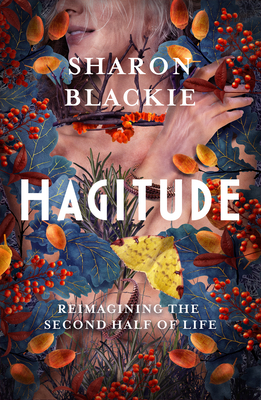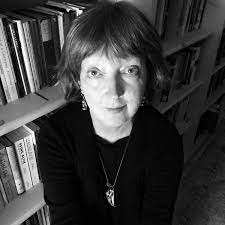Dr. Sharon Blackie wrote about menopause in her latest book book Hagitude: Reimagining the Second Half of Life (New World Library, 2022), and described it as “a time between stories, when the old story fades and a new story is waiting to emerge.” (See my last blog about the book.)
As a young woman in my late thirties, I had a hysterectomy which meant I didn’t go through the “time between stories” as Dr. Blackie refers to that particular time in a woman’s life, at least not in the way she is referring to it. I had though, definitely embarked on a new story.
 At this time, more than thirty years later, I’m reflecting on the final chapter of Hagitude: “The Valley of the Shadow of Death.” Dr. Blackie says she had never been “particularly preoccupied by death. Not until now.”
At this time, more than thirty years later, I’m reflecting on the final chapter of Hagitude: “The Valley of the Shadow of Death.” Dr. Blackie says she had never been “particularly preoccupied by death. Not until now.”
Dr. Blackie was diagnosed with non-Hodgkin’s Lymphoma – “one of the most aggressive hematological cancers, centered on lymphocytes: infection-fighting cells in the immune system.” She wasn’t frightened by the “life threatening nature of the illness itself” but by the toxic chemicals her body would have to endure for six months. She immersed herself in the lessons the illness had to teach her, seeing the lump on her neck not as an “evile alien invader” but as part of herself.
I can relate as I had a lump that was on my shin that I thought odd but not alien. It was diagnosed in the summer of 2015 as Spindle Cell Sarcoma. Although my body had to undergo CT scans, MRIs and the like, I didn’t have chemotherapy but rather radiation followed by surgery.
“The Guest House” by Sufi poet Rumi is a poem that Dr. Blackie includes in the last chapter of her book. The “guest” of cancer whispered in her ear: “If you want to live, you’re going to have to learn to walk hand in hand with death. If you’re going to write about elderhood as a big initiation – here’s an invitation for you. Don’t waste it now. It’s time to slough off another tough old skin.”
Among the lessons learned and gifts recognized by Dr. Blackie was kindness from people near and far as she had decided to go public with her diagnosis and treatment.
I received flowers from friends from afar including Sarah’s, my partner’s, former partner. I spent five weeks in Victoria, B.C. for radiation treatments and came home on weekends at which time I’d write a blog. I remember one faithful follower as being my poet friend Bill Cunningham who lived in Florida. He would send me an email in praise of poetry and offer me poems of his own along with his own heartfelt insight. Bill died of cancer on January 12, 2021.
The second gift Dr. Blackie received was slowing down. Dr. Blackie cleared her calendar several months ahead of treatment as her “sole focus was on recovery” and working on Hagitude if she could.
I loved clearing my calendar. It seemed to come at a time when I wanted to do that anyway. Part of the lesson is to do that before any sort of illness forces you to, to learn to create boundaries and say no.
The third gift that Dr. Blackie recognized as the most profound was “the opportunity to know and to befriend death.” She says “a key benefit” of a life-threatening illness is the “absolute necessity of forensically auditing your life.”
It’s a time to realize what’s important and if one survives, to continue living but in a new way as a transformation has taken place.
“And in this fallow time — in this ultimate place between stories – space is finally cleared for new growth,” Dr. Blackie says. It’s a clearing time, not a time for “new goals and new agendas.”
 At the end of the “brutal but restorative treatment,” Dr. Blackie had new insight and had reacquainted herself with delight, “with the pleasure of time and space to simply be.”
At the end of the “brutal but restorative treatment,” Dr. Blackie had new insight and had reacquainted herself with delight, “with the pleasure of time and space to simply be.”
It may sound strange to those who haven’t gone through treatment to hear some of us speaking fondly of the time we were required to rest. I thought I could skip back to Ontario possibly between radiation treatments and surgery, a period of about three months. The doctor said no, it was a time to rest. I went with that.
The challenges of a life-threatening illness are similar as we approach elderhood. Actually, I’m there now. Hagitude is to grow old seeing all there is to see in terms of an aging body, the likelihood of a serious illness, the inevitability of death with “clear and open eyes.” It’s time to “let the inessential fall away, and focus on the essence of who we are.”
And who are we? I do love the notion, and actually it’s based on ancient beliefs going back to Plato, that we have a calling in this life. James Hillman in his book The Soul’s Code declared: “Each person enters the world called.” This means we have a purpose and as Dr. Blackie sees it, our calling has “much more to do with ways of being in the world, rather than ways of doing” such as an occupation.
This final chapter in Hagitude, “The Valley of the Shadow of Death,” was to me the most important chapter in the book, the one that especially resonated with me. “We are always going to encounter paths that align us with our calling; the world never gives up on us,” Dr. Blackie says. Opportunities keep coming my way to offer writing circles in the community for instance. And in this very full and fulfilling life, I would also like to remember those times when I can simply be.

So relevant, this wonderful piece of writing, as death seems to be so present among friends and loved ones. Wrote a piece yesterday on Bill! His dying two years ago on Jan 12th. Much love and thanks for this M-A
Love and thanks back to you Richard. XO
Really loved this article, Mary Ann. Tender and touching and illuminating. I’m right here with you, Friend.
Thank you Linda! So glad to have you right here my friend.